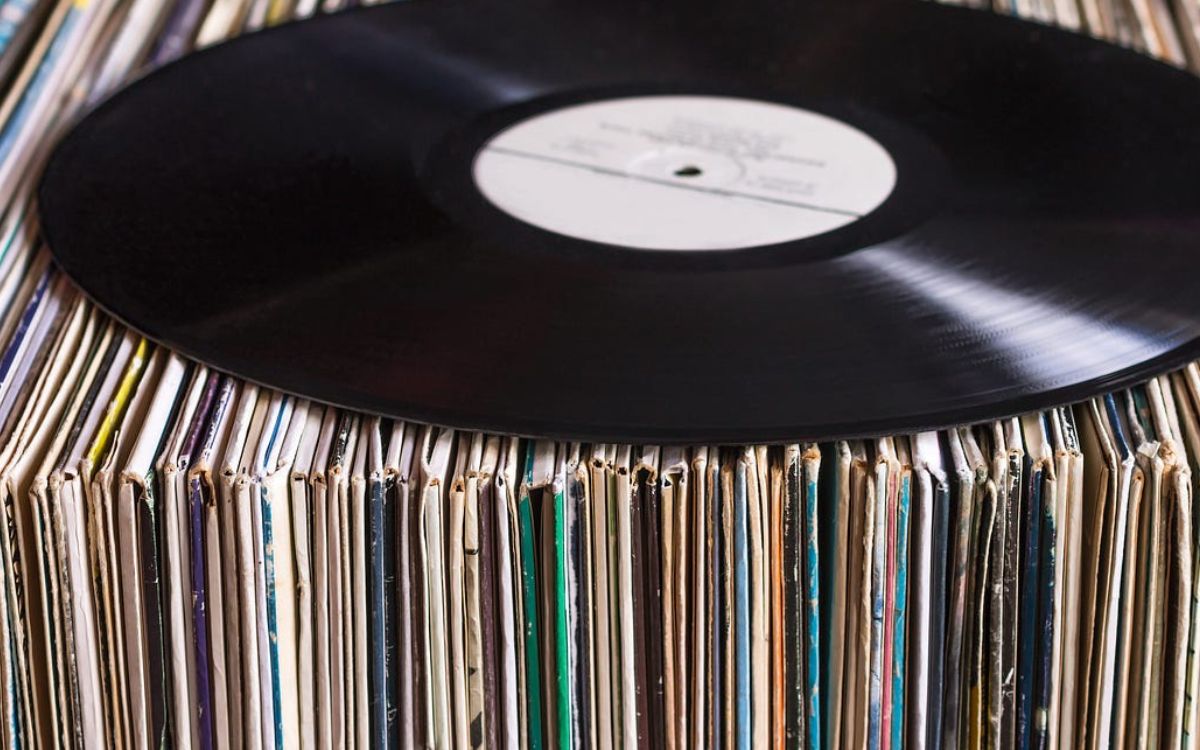Home>Production & Technology>Vinyl>Why Is Vinyl Important To Music Industries


Vinyl
Why Is Vinyl Important To Music Industries
Published: December 9, 2023
Discover why vinyl is crucial to the music industry and its enduring legacy. Explore the significance of vinyl records in the digital age and the unique experience they offer to music enthusiasts.
(Many of the links in this article redirect to a specific reviewed product. Your purchase of these products through affiliate links helps to generate commission for AudioLover.com, at no extra cost. Learn more)
Table of Contents
- Introduction
- Historical Significance of Vinyl Records
- Vinyl Resurgence in the Digital Age
- Music Industry’s Dependence on Vinyl Sales
- Vinyl’s Unique Listening Experience
- Vinyl as a Collectible Item
- Vinyl’s Impact on Music Merchandise
- Vinyl’s Influence on Music Production
- Vinyl’s Role in Supporting Independent Artists
- Conclusion
Introduction
Vinyl records have long played an important role in the music industry, influencing everything from how music is produced to how it is consumed. With their warm sound, tangible format, and inherent collectability, vinyl records have captivated music lovers for generations. Despite the rise of digital music and streaming platforms, vinyl has made a remarkable resurgence in recent years, appealing to both seasoned collectors and a new generation of music enthusiasts.
Historically, vinyl records have served as the primary medium for music distribution, with iconic albums and singles etched onto grooved discs. However, with the advent of CDs and digital downloads, many believed that vinyl would become obsolete. Yet, vinyl has managed to stand the test of time, proving to be more than just a nostalgic relic.
Not only has the vinyl revival sparked a renewed interest in physical music formats, but it has also revitalized the music industry as a whole. Vinyl sales have become a critical revenue stream for both major labels and independent artists, and its long-lasting influence extends beyond just the music itself.
In this article, we will delve into the historical significance of vinyl records, explore vinyl’s resurgence in the digital age, examine the music industry’s dependence on vinyl sales, delve into the unique listening experience that vinyl offers, and analyze the impact of vinyl on music merchandise and production. We will also discuss the role of vinyl in supporting independent artists and the evolving landscape of the music industry as it embraces this beloved format.
So, join us on this journey as we explore why vinyl remains an indispensable part of the music industry and a cherished medium for music lovers worldwide.
Historical Significance of Vinyl Records
Vinyl records have a rich history that dates back to the late 19th century. In 1877, Thomas Edison successfully invented the phonograph, a device capable of recording and reproducing sound. However, it wasn’t until the early 20th century that vinyl records as we know them today began to take shape.
In 1948, Columbia Records introduced the long-playing (LP) record, revolutionizing the music industry. Unlike previous formats such as shellac and shellac-coated 78-rpm records, which were fragile and limited in their playback time, vinyl LPs offered improved sound quality and the ability to hold more music on a single disc. This innovation allowed for longer, uninterrupted recordings, paving the way for concept albums and artistic expression in popular music.
Throughout the 1950s and 1960s, vinyl record sales skyrocketed, with artists like Elvis Presley, The Beatles, and The Rolling Stones dominating the charts and solidifying vinyl’s place as the primary medium for music consumption. The vinyl record became more than just a vessel for music; it became a cultural phenomenon and a symbol of an era.
By the 1980s, however, vinyl faced stiff competition from the compact disc (CD), which offered a more compact, durable, and convenient way to listen to music. Many predicted the decline of vinyl, yet it managed to hold its ground, albeit with a smaller market share.
Fast forward to the 21st century, and vinyl is once again experiencing a resurgence. Music lovers, both young and old, have developed a renewed appreciation for the warm and authentic sound of vinyl records. The act of playing a vinyl record has become a deliberate ritual, with the physicality of handling the record, placing it on the turntable, and carefully dropping the needle all adding to the overall listening experience.
In recent years, vinyl sales have been steadily increasing, with artists across various genres releasing new albums on vinyl and reissuing classic albums in remastered formats. Record stores, both independent and chain, have reemerged as cultural hubs for music enthusiasts looking to discover new artists and expand their vinyl collections.
The historical significance of vinyl records cannot be understated. They have not only shaped the way music is enjoyed but have also become revered cultural artifacts that tell the story of music’s evolution over the years. As we continue to explore the vinyl resurgence, we will uncover the profound impact this format has had on the music industry and its enduring appeal as more than just a medium for music.
Vinyl Resurgence in the Digital Age
In the digital age, where music can be streamed with a simple click and stored in vast digital libraries, the resurgence of vinyl records might seem surprising to some. However, the appeal of vinyl lies in its tangibility and the unique experience it offers.
One of the key factors driving the vinyl resurgence is the longing for a more physical and tactile music experience. In a world dominated by intangible digital files, vinyl records bring back a sense of connection to the music. Holding a vinyl record, flipping it over to side B, and carefully placing it on a turntable creates a ritualistic experience that engages multiple senses.
Additionally, vinyl records provide a superior sound quality compared to compressed digital files. Audiophiles and music enthusiasts argue that the analog sound captured on vinyl creates a warmer, fuller, and more dynamic listening experience. The inherent imperfections in vinyl, such as the occasional crackle or pop, add character and authenticity to the music.
The vinyl revival has also been fueled by the rise of the collector culture. Vinyl records offer a tangible and collectible aspect that digital files simply cannot replicate. From limited edition pressings to colored vinyl variants, the physicality of vinyl records appeals to collectors who cherish the uniqueness and rarity each release brings.
Furthermore, vinyl records have become more accessible in the digital age. Online marketplaces and record stores have made it easier than ever for music lovers to find and purchase vinyl records. Independent record labels and artists have embraced vinyl as a way to connect with fans and offer exclusive releases. This accessibility has expanded the audience for vinyl, attracting both long-time collectors and new enthusiasts alike.
The resurgence of vinyl in the digital age has also highlighted the value of album artwork and liner notes. While digital platforms often reduce album covers to small thumbnail images, vinyl records allow for larger, more visually striking artwork that complements the music. The tangible nature of vinyl also facilitates the inclusion of detailed and immersive liner notes, providing additional context and insight into the artist’s creative process.
Overall, the vinyl resurgence in the digital age reminds us of the enduring appeal of physical media and the desire for a more intentional and engaging music experience. As we delve further into the impact of vinyl on the music industry, we will discover how its resurgence has impacted sales, production, and the overall landscape of music consumption.
Music Industry’s Dependence on Vinyl Sales
The resurgence of vinyl records has had a significant impact on the music industry, transforming it into a vinyl-driven market once again. With the rise in vinyl sales, the industry has recognized the economic potential of this format and has adapted its strategies accordingly.
For major record labels, vinyl sales have become a crucial source of revenue. In an era dominated by streaming services, vinyl offers a higher profit margin per unit sold. The higher price point of vinyl records compared to digital downloads or streaming subscriptions allows labels to generate more income from each sale.
Independent artists and labels have also benefited greatly from the vinyl resurgence. Vinyl provides an opportunity for artists to connect with their audience on a deeper level, offering a physical representation of their music and a tangible product for fans to collect. Many independent artists have embraced vinyl as a means of monetization and as a way to engage with their loyal fan base.
Vinyl releases have also become a powerful marketing tool for both established and emerging artists. Limited edition vinyl pressings and exclusive variants create a sense of scarcity and desirability, driving increased demand and generating buzz around an artist’s music. This hype can extend to other formats and even boost streaming numbers, as vinyl enthusiasts often share and promote their physical purchases on social media platforms.
Music retailers, both online and brick-and-mortar, have experienced the positive effects of the vinyl resurgence. Independent record stores, in particular, have witnessed a revival, as vinyl collectors flock to these communal spaces to browse, discover, and add to their collections. Record Store Day, an annual event dedicated to independent record stores and vinyl culture, has become a vital catalyst for vinyl sales, with exclusive releases and in-store events attracting enthusiastic music lovers.
The music industry’s dependence on vinyl sales extends beyond physical records. Merchandising has also become closely tied to vinyl releases. Artists often bundle vinyl records with additional merchandise, such as t-shirts, posters, and even exclusive experiences, creating a comprehensive package that caters to fans’ desire for a more immersive and interactive music experience.
Overall, the dependence on vinyl sales has breathed new life into the music industry, offering a tangible and lucrative avenue for both major labels and independent artists. Vinyl records have become an essential piece of the industry’s revenue puzzle, rejuvenating the market and proving that physical formats can coexist with digital platforms.
Vinyl’s Unique Listening Experience
One of the key reasons for the enduring popularity of vinyl records is the unique listening experience they provide. Vinyl offers a tangible and immersive way to engage with music that digital formats cannot replicate.
First and foremost, vinyl records offer a warm and rich sound quality that many audiophiles and music enthusiasts appreciate. The analog nature of vinyl provides a distinct character to the music, with its inherent imperfections adding depth and texture. The crackling sounds and gentle pops that may occasionally accompany the playback of a vinyl record bring a nostalgic charm to the listening experience.
The physical act of playing a vinyl record also adds to the sense of engagement. From carefully removing the record from its sleeve to delicately placing it on the turntable, vinyl forces the listener to be present and involved in the music. Dropping the needle onto the spinning record becomes a deliberate ritual, heightening anticipation before the music starts.
Furthermore, vinyl rewards active listening. Unlike digital platforms where music can be easily skipped or shuffled, vinyl records demand that the listener listen to the album in its entirety, from start to finish. This encourages a focused and uninterrupted experience, allowing the listener to fully immerse themselves in the artist’s intended sequence and vision for the album.
Album artwork also plays a significant role in the vinyl listening experience. The larger format of vinyl records allows for more elaborate and visually striking album covers, providing a truly immersive visual experience that complements the music. The artwork becomes an extension of the artist’s creative expression, enhancing the overall aesthetic and creating a deeper connection between the listener and the music.
Add to this the inclusion of lyric sheets, liner notes, and additional artwork inserts, and vinyl becomes a complete sensory experience. These additional elements provide insights into the artist’s inspirations, songwriting process, and personal reflections, offering a deeper appreciation for the music and the artist’s creative journey.
Overall, the unique listening experience of vinyl records offers a respite from the digital age of instant gratification and constant distractions. It allows music lovers to slow down, savor the music, and reconnect with the artistry and craftsmanship of the album format. Vinyl records offer a sense of authenticity, nostalgia, and intricacy that taps into our humanity and rekindles our love for music in a way that no digital format can replicate.
Vinyl as a Collectible Item
Vinyl records have long been coveted by collectors for their intrinsic value as cultural artifacts and their inherent rarity. The resurgence of vinyl has only fueled the passion for collecting these records, turning them into highly sought-after and valuable items.
One of the primary reasons why vinyl records are prized as collectibles is their limited availability. Many artists and labels release vinyl editions in limited quantities, often accompanied by exclusive artwork, colored vinyl, or special packaging. These limited editions create a sense of scarcity, making them highly desirable among collectors.
Collecting vinyl records is not just about owning the music; it’s about owning a piece of music history. Collectors seek out different versions of albums, special editions, and first pressings, as these hold historical and cultural significance. Vintage vinyl records from the early days of rock ‘n’ roll or iconic albums from influential artists have become highly valuable and much sought-after by collectors.
Moreover, vinyl records offer a visual appeal that digital formats lack. The large album artwork, vibrant sleeve designs, and unique vinyl colors all contribute to the visual allure of vinyl records. Collectors often display their records on shelves or frame them as art pieces, showcasing the beauty of the format and creating an immersive environment that celebrates their love for music and aesthetic appreciation.
The act of collecting vinyl records also fosters a sense of community. Record fairs, swap meets, and online forums bring collectors together to share their passion, trade or sell records, and expand their collections. These spaces allow enthusiasts to connect, discover new music, and learn from one another, creating bonds forged through a shared love for vinyl records.
The value of vinyl records as collectible items extends beyond monetary worth. Collecting vinyl is a way to preserve and appreciate the cultural heritage of music. It allows for a physical connection to the music and the artists, as well as the opportunity to explore different genres and eras through the medium of vinyl records.
As the vinyl resurgence continues, the demand for collectible records is expected to grow. Record labels and artists recognize the appeal of vinyl as a collectible item and often release exclusive editions or special reissues to cater to collectors. With their scarcity, visual appeal, and cultural significance, vinyl records will remain a highly sought-after and cherished item among music collectors for years to come.
Vinyl’s Impact on Music Merchandise
The resurgence of vinyl records has had a significant impact on the world of music merchandise. As vinyl sales continue to rise, artists and labels have recognized the opportunity to expand their merchandise offerings and provide fans with more tangible and collectible items.
Vinyl records have become a cornerstone of music merchandise. Artists often release exclusive vinyl editions of their albums, featuring limited edition pressings, colored vinyl variants, or deluxe packaging. These special releases create a sense of exclusivity and desirability, enticing fans to add these unique vinyl records to their collections.
Vinyl releases also contribute to the overall branding and visual identity of an artist. Album artwork and packaging play a significant role in the marketing and promotion of an album, with vinyl offering a larger canvas for visually striking designs. Artists and labels put a great deal of thought into the presentation of their vinyl releases, making them not only enjoyable to listen to but also visually appealing as a physical product.
Moreover, vinyl records often come bundled with additional merchandise. Artists take advantage of the vinyl format to create comprehensive merchandise packages that include clothing, posters, stickers, and other collectible items. These bundles enhance the overall fan experience, allowing fans to display their support for the artist and connect with them on a deeper level.
The popularity of vinyl records as music merchandise has also revitalized the role of physical retail spaces, particularly independent record stores. These stores serve as hubs for vinyl enthusiasts, offering not only a wide selection of records but also a range of merchandise options. From band t-shirts and hoodies to accessories like pins and patches, record stores have become go-to destinations for fans looking to engage with their favorite artists beyond just the music.
Furthermore, vinyl records have become a catalyst for special events and exclusive collaborations. Record Store Day, an annual event dedicated to celebrating independent record stores and vinyl culture, sees artists and labels create exclusive releases and limited edition vinyl variants. These events create a sense of excitement and encourage fans to visit their local record stores, supporting physical retail spaces and fostering a sense of community within the music industry.
The impact of vinyl on music merchandise goes beyond revenue generation. It allows artists to connect with their audience on a deeper level, offering an extension of their artistic vision and creating a more immersive fan experience. Fans, in turn, can proudly display their vinyl records and associated merchandise, showcasing their support and dedication to their favorite artists.
As the vinyl resurgence continues its momentum, we can expect to see even more innovation and creativity in the realm of music merchandise. Vinyl will undoubtedly remain a central piece of the music merchandise puzzle, offering a tangible and collectible format that fans can cherish and enjoy for years to come.
Vinyl’s Influence on Music Production
Vinyl records have had a profound influence on music production, shaping not only the way music sounds but also the creative approach taken by artists and producers. The unique characteristics of vinyl as a format have sparked innovation and contributed to the sonic landscape of music.
First and foremost, vinyl records have played a critical role in shaping the sound of popular music. The physical limitations of vinyl, such as its dynamic range and frequency response, have influenced the production techniques used to master tracks for vinyl release. Engineers and producers take into account the medium’s limitations, ensuring that the music translates effectively to vinyl and sounds its best when played on a turntable.
Additionally, vinyl’s inherent warm and analog sound has prompted many artists and producers to strive for a vintage and organic sound in their recordings. The imperfections and subtle nuances that come with vinyl playback, such as the occasional crackle or surface noise, add character and charm to the music. This desire for a vintage aesthetic has led to a resurgence of analog recording techniques, such as recording to tape, to capture the warmth and depth that vinyl lovers appreciate.
Vinyl records have also influenced the structure and sequencing of albums. The physical limitations of vinyl, with its finite capacity and division into sides A and B, have influenced the way artists arrange their tracks and create cohesive album experiences. The concept of side A and side B encourages artists to craft a narrative or sonic journey within the album, carefully considering the flow of songs and the balance between different moods and musical styles.
Furthermore, vinyl has impacted the mastering process. Vinyl mastering involves specific techniques to optimize the playback experience while minimizing potential issues like inner groove distortion. Engineers work closely with artists to fine-tune their mixes, ensuring that the sound translates well to vinyl and retains its quality throughout the playback process. This attention to detail in the mastering stage ensures that the music sounds its best and captures the essence of the artist’s vision on vinyl.
Vinyl’s influence on music production extends beyond just the technical aspects. The resurgence of vinyl has reignited an appreciation for the album format as a whole. Artists and producers are once again embracing the idea of crafting complete album experiences, focusing on the sequencing, album art, and overall cohesiveness of the project. Vinyl’s natural inclination toward albums has encouraged artists to put greater thought and effort into curating their music in a way that resonates with listeners.
Overall, vinyl records have left an indelible mark on music production. From shaping the sound of music to influencing the way albums are structured and sequenced, vinyl has brought about a renewed focus on quality and craftsmanship. Its influence on both the technical and creative aspects of music production has solidified vinyl’s enduring place in the music industry.
Vinyl’s Role in Supporting Independent Artists
Vinyl records have played a crucial role in supporting independent artists, offering them a platform to connect with fans on a deeper level and generate revenue to sustain their creative endeavors. The resurgence of vinyl has provided independent artists with a renewed opportunity to share their music and build a dedicated fan base.
Vinyl releases allow independent artists to showcase their music in a tangible and collectible format. Many independent artists take full advantage of vinyl’s aesthetic appeal, creating visually striking album artwork and special editions that capture the essence of their music. The physicality of vinyl records adds a layer of authenticity and permanence to an artist’s work, attracting collectors and enhancing the overall fan experience.
Moreover, vinyl provides independent artists with a unique revenue stream. While streaming services offer exposure and accessibility, they often provide minimal financial returns to artists, especially those at the independent level. Vinyl sales, on the other hand, offer a higher profit margin per unit sold and can provide a more sustainable income for independent artists, helping to fund future recordings, tours, and other creative projects.
Vinyl releases also foster a stronger connection between independent artists and their fan base. Through limited edition pressings, signed copies, and personalized artwork, artists can offer a more intimate experience for their supporters, creating a sense of exclusivity and appreciation. Fans who purchase vinyl records directly from independent artists often feel a deeper sense of connection, knowing that their purchase directly supports the artists they love.
The vinyl resurgence has coincided with the rise of independent record stores, which have become important outlets for independent artists to distribute their music. These stores not only provide a physical space for artists to sell their vinyl releases but also act as community hubs for music enthusiasts and avid collectors. Independent artists can connect with and cultivate relationships with these stores, helping to expand their reach and gain exposure to new audiences beyond their immediate fan base.
Additionally, vinyl releases allow independent artists to curate their musical offerings in a deliberate and focused manner. The limited capacity of vinyl records encourages artists to carefully select and sequence their tracks, ensuring that their music flows cohesively and tells a compelling narrative. This level of intentionality captures the attention of listeners and offers a more immersive and engaging experience.
Overall, vinyl records have opened up avenues of support and visibility for independent artists. This format not only offers a tangible and collectible representation of their music but also serves as a means of generating revenue and connecting with their fan base. Vinyl has become a vital tool for independent artists to share their creativity, leave a lasting impact, and build a sustainable career in the ever-evolving music industry.
Conclusion
The resurgence of vinyl records in the music industry has proven to be far more than just a passing trend. Vinyl’s historical significance, coupled with its unique listening experience, has sparked a renewed love for this tangible and collectible format. Vinyl has not only revitalized the music industry but also influenced various aspects of the music landscape.
Historically, vinyl records have served as the primary medium for music distribution, and their resurgence in the digital age is a testament to their enduring appeal. Vinyl offers a warm and authentic sound, encouraging active and intentional listening. The vinyl experience goes beyond just the music itself, incorporating stunning album artwork, immersive liner notes, and a special appreciation for the ritualistic act of playing a record.
Vinyl’s impact extends to the music industry by providing a critical revenue stream, especially for independent artists. The limited availability and collectible nature of vinyl have created a niche market, where artists can connect more intimately with their fans and create a sustainable income. Vinyl records have also influenced music merchandise, with artists using vinyl releases as a centerpiece for bundled merchandise and exclusive collaborations.
The influence of vinyl on music production cannot be understated. Vinyl’s unique characteristics have shaped the way music is mastered, influencing production techniques and fostering a renewed emphasis on album sequencing and cohesiveness. Vinyl’s warm, analog sound has inspired artists and producers to pursue a vintage aesthetic and embrace analog recording methods.
Above all, vinyl has played a crucial role in supporting independent artists. Vinyl releases offer independent artists a tangible platform to share their creativity and connect with fans on a deeper level. Vinyl’s resurgence, combined with the rise of independent record stores, has provided a valuable avenue for artists to distribute their music, generate revenue, and foster a passionate fan base.
In conclusion, vinyl records continue to play a significant role in the music industry, offering a distinct and cherished listening experience. From its historical significance to its impact on music production and its support of independent artists, vinyl remains an indispensable and beloved medium for music lovers worldwide. As the vinyl resurgence continues, we can anticipate further innovation and creativity in the world of vinyl records, ensuring that they will remain a cherished part of the music industry for generations to come.











